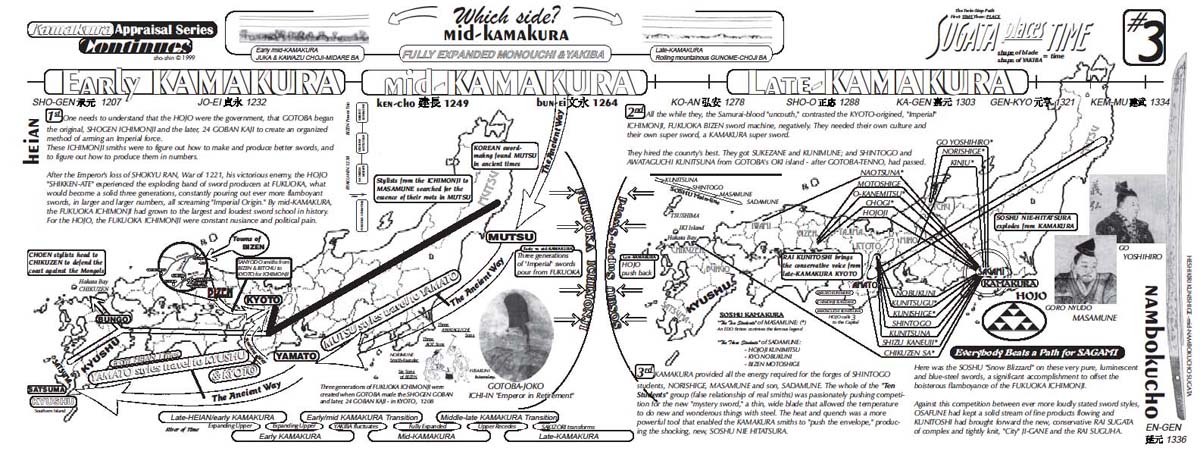|
|
KAMAKURA
ICHIMONJI
|
KOKUHO MEI-BUTSU NIKKO SUKEZANE
KOKUHO NIKKO SUKEZANE NAGASA: 71.2cm SORI: 2.5cm A possession of IYEYASU. Following the SHOGUN's death, it was transferred to the famous TOKUGAWA Shrine, NIKKO TOSHOGU. This is the foremost example of his KAMAKURA period work. Small signature and banners the exaggerated parameters of the Soshu styles being produced at the Kamakura capitol. Note the wide and charged expression to the Yakiba. The KAMAKURA ICHIMONJI mark. SHINOGI-TSUKURI, IHORI-MUNE, wide mid-KAMAKURA TACHI SUGATA. A bold BO-HI spines the strong IKUBI-KISSAKI. Classic full SUGATA of the mid-KAMAKURA, it mimics the prior extension of SUGATA parameters from the mid-HEIAN, SAMPIRA JIDAI, and fore-runs the even more exaggerated SUGATA of the coming NAMBOKUCHO. - SOSHU had these swords to copy. Strongly defined ITAME HADA with JI-NIE stands under MIDARE-UTSURI. Deep NIOI-FUKASHI and KO-NIE O-CHOJI MIDARE BA pushes TOGARI pinnacles and falling ASHI through rivers of SUNAGASHI and YO. MIDARE-KOMI BOSHI finds a brushed head at the SAKI. URA BO-HI drops to the butt of the tang. Two holes, SURIAGE NAKAGO is signed against the MUNE.
|
BUNKAZAI SUKETSUNA
BUNKAZAI SUKETSUNA
NAGASA: 74.5cm SORI: 1.97cm This sword had been JUYO BIJUTSU-HIN,"JU-BI" and was awarded BUNKAZAI when the former distinction was changed following WWII. A beautiful URA-MEI TACHI in the style of his teacher, SUKEZANE. His work-period is BUN-EI 1264, solidly into SUKEZANE's time in KAMAKURA and therefore appropriate in presentations of the KAMAKURA ICHIMONJI. It was made SURIAGE in the time of HIDEYOSHI. Old-style small "Twin Flowers" SAKA-GUNOME and CHOJI figures are strafed with KINSUJI and SUNAGASHI. BOSHI is HOSO Swept KINSUJI to a slight KAERI at the SAKI. Two MEKUGI-ANA O-SURIAGE NAKAGO is signed along the MUNE at the very bottom.
|
______________________ |
|
||||
|
Notes on KAMAKURA Style
RAI: Refined and distinctive SUGUHA They also incorporate the popular OSAFUNE GUNOME, taken up by the AWATAGUCHI but popularized of the RYAKU-NIN powerhouse three: HATAKEDA MORIIYE - OSAFUNE MITSUTADA - SABURO KUNIMUNE OSAFUNE: MITSUTADA's brilliant undulating GUNOME-CHOJI BA is irresistibly infectious. Generations of workers proudly take their turns holding the same seats at the same table. FUKUOKA: JUKA and OBUSA KAWAZU CHOJI-MIDARE BA FUKUOKA pulls out all stops to grab and hold the prize SOSHU: Stealing BIZEN's undulating GUNOME, they forge fantastic steel into fantastic structures. |
 |
|